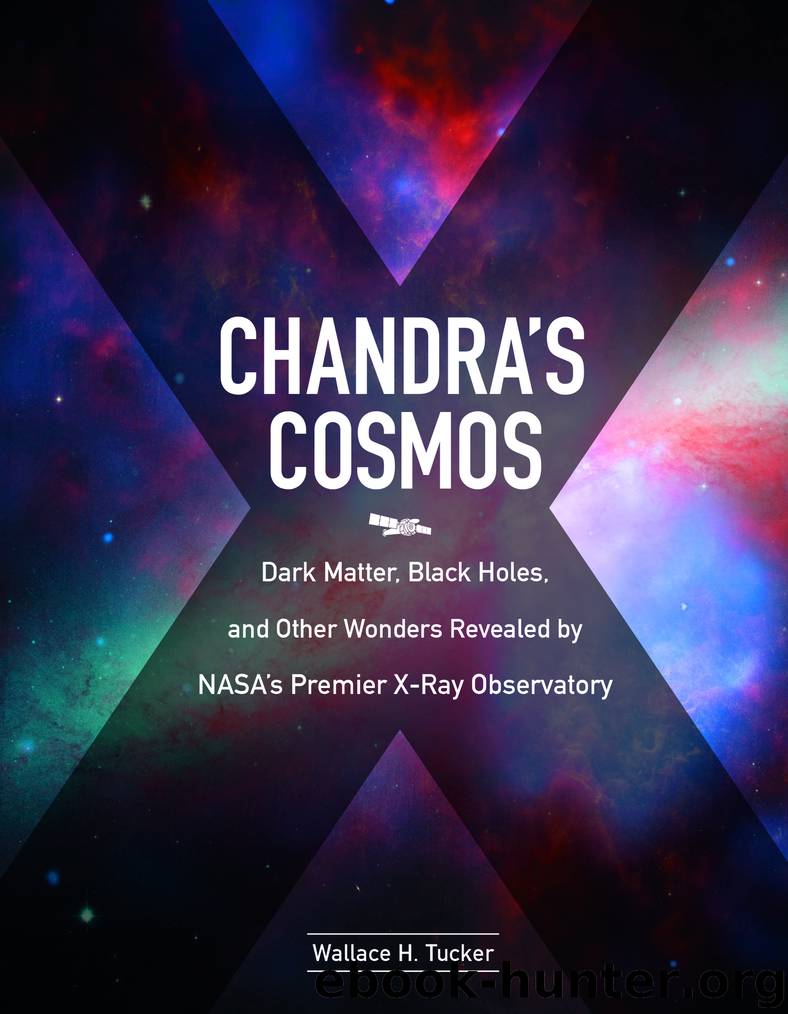Chandra's Cosmos by Wallace H. Tucker

Author:Wallace H. Tucker
Language: eng
Format: epub
Publisher: Smithsonian
Published: 2017-03-27T16:00:00+00:00
14
If a car was as fuel-efficient as these black holes, it could theoretically travel over a billion miles on a gallon of gas.
Christopher Reynolds, NASA press release, 2006
GREEN BLACK HOLES
Black holes have a reputation for being the ultimate sinks of matter and energy. To a certain extent, that reputation is well deserved. Matter falling beyond the event horizon of a black hole cannot escape, and it is forever out of touch with the rest of the universe. However, this is not the whole story.
For stellar mass black holes, the matter consumed by the black hole comes from a companion star. For a supermassive black hole, the menu is much more diverse. It can be gas that has escaped from stars in the neighborhood, which can encompass several hundred light-years. Or it can be comets or planets that stray too close to the black hole. Stars, too, can become food. The pull of the supermassive black hole’s gravity is greater on the side of the star near the black hole than on its far side. These gravitational tidal forces can stretch the star into a long sausage shape and ultimately pull it apart. After the star is destroyed, the black hole’s strong gravitational force pulls most of the remains of the star toward it. This infalling debris is heated to millions of degrees Celsius and generates a bright X-ray flare, which gradually fades over a few years as the material falls beyond the black hole’s event horizon.
A familiar—but fortunately much milder—example of tidal force is the differing gravitational force exerted by the Moon on the near and far sides of Earth. This force differential, or tidal force, stretches Earth out of round and produces lunar ocean tides. Several astrophysicists first discussed the possibility of tidal disruption of stars by supermassive black holes forty years ago. However, the first strong evidence for stellar death by black holes came in the form of a powerful X-ray outburst from the center of the galaxy RXJ1242-11. The outburst was tracked by Chandra, XMM-Newton, and the German Roentgensatellite, which is no longer operational. Other bright flares have been seen from galaxies, but this is the first one that occurred when Chandra and XMM-Newton were in orbit. Chandra located the event precisely, and XMM-Newton measured the spectral distribution of the X-rays emitted in the outburst. The results of these combined observations fit with a tidal disruption explanation, and they enabled researchers to rule out other possibilities for the X-ray outburst. One of the brightest flare-ups ever detected in a galaxy, it was deemed to have been caused by gas from the destroyed star that was heated to millions of degrees Celsius before being swallowed by the black hole.
The supermassive black hole in RXJ1242-11 is estimated to have a mass of about 100 million Suns. In contrast, the destroyed star likely had a mass about equal to the Sun. “This is the ultimate David versus Goliath battle, but here David lost,” said Gunther Hasinger of the Max Planck Institute for Extraterrestrial Physics in Germany, one of the coauthors of the study.
Download
This site does not store any files on its server. We only index and link to content provided by other sites. Please contact the content providers to delete copyright contents if any and email us, we'll remove relevant links or contents immediately.
| Aeronautics & Astronautics | Astronomy |
| Astrophysics & Space Science | Comets, Meteors & Asteroids |
| Cosmology | Mars |
| Solar System | Star-Gazing |
| Telescopes | UFOs |
Tools of Titans by Timothy Ferriss(8216)
Turbulence by E. J. Noyes(7935)
Secrets of Antigravity Propulsion: Tesla, UFOs, and Classified Aerospace Technology by Ph.D. Paul A. Laviolette(5309)
Astrophysics for People in a Hurry by Neil DeGrasse Tyson(5130)
Room 212 by Kate Stewart(5035)
Design of Trajectory Optimization Approach for Space Maneuver Vehicle Skip Entry Problems by Runqi Chai & Al Savvaris & Antonios Tsourdos & Senchun Chai(5011)
Pale Blue Dot by Carl Sagan(4909)
The David Icke Guide to the Global Conspiracy (and how to end it) by David Icke(4624)
A Journey Through Divination and Astronomy by Publishing Pottermore(4344)
Goodbye Paradise(3726)
Apollo 8 by Jeffrey Kluger(3635)
COSMOS by Carl Sagan(3553)
Losing the Nobel Prize by Brian Keating(3498)
The Five People You Meet in Heaven by Mitch Albom(3474)
How to Read Water: Clues and Patterns from Puddles to the Sea (Natural Navigation) by Tristan Gooley(3406)
Brief Answers to the Big Questions by Stephen Hawking(3369)
How to Read Nature by Tristan Gooley(3249)
The Order of Time by Carlo Rovelli(3145)
A Brief History of Time by Stephen Hawking(2959)
